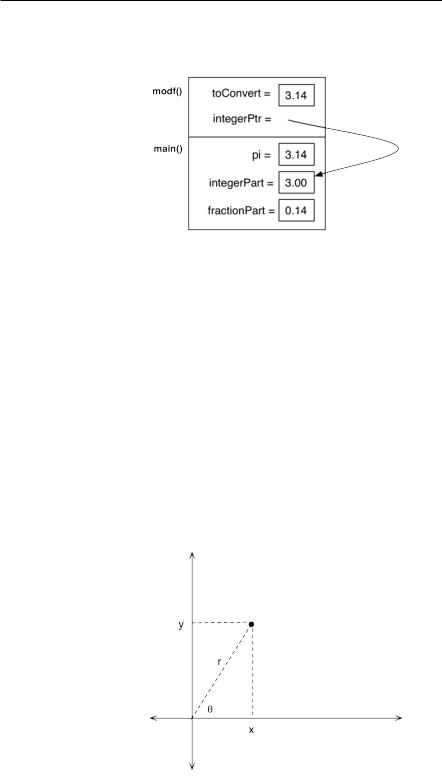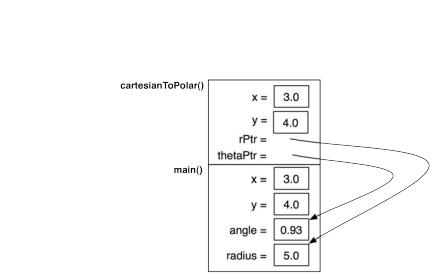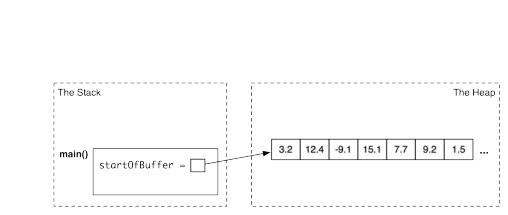
- •C and Objective-C
- •How this book works
- •How the life of a programmer works
- •Installing Apple’s developer tools
- •Getting started with Xcode
- •Where do I start writing code?
- •How do I run my program?
- •So what is a program?
- •Don’t stop
- •Types
- •A program with variables
- •Challenge
- •Boolean variables
- •When should I use a function?
- •How do I write and use a function?
- •How functions work together
- •Local variables, frames, and the stack
- •Recursion
- •Looking at the frames in the debugger
- •return
- •Global and static variables
- •Challenge
- •printf()
- •Integer operations
- •Integer division
- •Operator shorthand
- •Floating-point numbers
- •Tokens for displaying floating-point numbers
- •The while loop
- •The for loop
- •break
- •continue
- •The do-while loop
- •Challenge
- •Getting addresses
- •Storing addresses in pointers
- •Getting the data at an address
- •How many bytes?
- •NULL
- •Stylish pointer declarations
- •Challenges
- •Writing pass-by-reference functions
- •Avoid dereferencing NULL
- •Creating and using your first object
- •Message anatomy
- •Objects in memory
- •Challenge
- •Nesting message sends
- •Multiple arguments
- •Sending messages to nil
- •Challenge
- •Challenge
- •NSMutableArray
- •Reference pages
- •Quick Help
- •Other options and resources
- •Accessor methods
- •Dot notation
- •Properties
- •self
- •Multiple files
- •Challenge
- •Overriding methods
- •super
- •Challenge
- •Object ownership and ARC
- •Creating the Asset class
- •Adding a to-many relationship to Employee
- •Challenge
- •Retain cycles
- •Weak references
- •Zeroing of weak references
- •For the More Curious: Manual reference counting and ARC History
- •Retain count rules
- •NSArray/NSMutableArray
- •Immutable objects
- •Sorting
- •Filtering
- •NSSet/NSMutableSet
- •NSDictionary/NSMutableDictionary
- •Preprocessor directives
- •#include and #import
- •#define
- •Global variables
- •enum
- •#define vs global variables
- •Writing an NSString to a file
- •Reading files with NSString
- •Writing an NSData object to a file
- •Reading an NSData from a file
- •Target-action
- •Helper objects
- •Notifications
- •Which to use?
- •Callbacks and object ownership
- •Challenge
- •Getting started with iTahDoodle
- •BNRAppDelegate
- •Adding a C helper function
- •Objects in iTahDoodle
- •Model-View-Controller
- •The application delegate
- •Setting up views
- •Running on the iOS simulator
- •Wiring up the table view
- •Adding new tasks
- •Saving task data
- •For the More Curious: What about main()?
- •Edit BNRDocument.h
- •A look at Interface Builder
- •Edit BNRDocument.xib
- •Making connections
- •Revisiting MVC
- •Edit BNRDocument.m
- •Writing init methods
- •A basic init method
- •Using accessors
- •init methods that take arguments
- •Deadly init methods
- •Property attributes
- •Mutability
- •Lifetime specifiers
- •copy
- •More about copying
- •Advice on atomic vs. nonatomic
- •Key-value coding
- •Non-object types
- •Defining blocks
- •Using blocks
- •Declaring a block variable
- •Assigning a block
- •Passing in a block
- •typedef
- •Return values
- •Memory management
- •The block-based future
- •Challenges
- •Anonymous block
- •NSNotificationCenter
- •Bitwise-OR
- •Bitwise-AND
- •Other bitwise operators
- •Exclusive OR
- •Complement
- •Left-shift
- •Right-shift
- •Using enum to define bit masks
- •More bytes
- •Challenge
- •char
- •char *
- •String literals
- •Converting to and from NSString
- •Next Steps
- •Index

Chapter 9 Pass By Reference
Figure 9.1 The stack as modf() returns
Here’s another way to think about pass-by-reference. Imagine that you give out assignments to spies. You might tell one, “I need photos of the finance minister with his girlfriend. I've left a short length of steel pipe at the foot of the angel statue in the park. When you get the photos, roll them up and leave them in the pipe. I'll pick them up Tuesday after lunch.” In the spy biz, this is known as a dead drop.
modf() works just like a dead drop. You are asking it to execute and telling it a location where the result can be placed so you can find it later. The only difference is that instead of a steel pipe, you are giving it a location in memory where the result can be placed.
Writing pass-by-reference functions
There are two popular ways to describe the location of a point in 2-dimensional space: Cartesian coordinates and polar coordinates. In Cartesian coordinates, (x, y) indicates that you should go to the right x and then up y. In polar coordinates, (theta, radius) indicates that you should turn to the left by theta radians and go forward radius.
Figure 9.2 Polar and Cartesian coordinates
62

0 5 & &
B & ) + + &) "
L + ) + & )' ) + & )' ! ( & &) + ) * * 7
; C E! ?! " C ! " C %
( + &) + " ) & E ?! + ) + + " ) & !
+ + &) & ) & & ' 7
# . I1 "1 # ! 1 # ! 7
6 # ! ! # ##
) O I I 4 " "
2 !
I )) & & 7
" )) & & 7
) & & " # # ! # #
8 " > & 7
) %G G,
8 7
) %G G,
8
8 7
) " I
8
6 ! # ##
)
8
! " #$%
&
I 5 9=,
C ,
C ,
C C
C I ! L C %,
@ C
' C I Q-! C I Q 7 + '! C ! C %,
# ! I ) C &
# ! " ) + &
# ! # !
# !
. I1 "1 M # ! 1 M
0 , 1 0 , 0 , # 1 0 , 1 I1 "1 # ! 1
-,
.
) ) '!
<

Chapter 9 Pass By Reference
Figure 9.3 The stack as cartesianToPolar() returns
Avoid dereferencing NULL
Sometimes a function can supply many values by reference, but you may only care about some of them. How do you avoid declaring these variables and passing their addresses when you’re not going to use them anyway? Typically, you pass NULL as an address to tell the function “I don’t need this particular value.”
This means that you should always check to make sure the pointers are non-NULL before you dereference them. Add these checks in cartesianToPolar():
void cartesianToPolar(float x, float y, double *rPtr, double *thetaPtr)
{
// Is rPtr non-NULL? if (rPtr) {
// Store the radius in the supplied address *rPtr = sqrt(x * x + y * y);
}
// Is thetaPtr NULL? if (!thetaPtr) {
// Skip the rest of the function return;
}
// Calculate theta float theta;
if (x == 0.0) {
if (y == 0.0) {
theta = 0.0; // technically considered undefined
}else if (y > 0) { theta = M_PI_2;
}else {
theta = - M_PI_2;
}
} else {
...
64

10
Structs
Sometimes you need a variable to hold several related chunks of data. For example, imagine that you were writing a program that computed a person’s Body Mass Index. (What is your BMI? It is your weight in kilograms divided by the square of your height in meters. A BMI under 20 suggests that you may be underweight. A BMI over 30 suggests that you may be obese. It is a very imprecise tool for measuring a person’s fitness, but it makes a fine programming example.) A person, for your purposes, consists of a float that represents height in meters and an int that represents weight in kilograms.
Now you’re going to create your own Person type. A variable of type Person will be a structure and will have two members: a float called heightInMeters and an int called weightInKilos.
Create a new project: a C Command Line Tool called BMICalc. Edit main.c to create a structure that contains the data you need for a person:
#include <stdio.h>
// Here is the declaration of the struct Person struct Person {
float heightInMeters; int weightInKilos;
};
int main(int argc, const char * argv[])
{
struct Person person; person.weightInKilos = 96; person.heightInMeters = 1.8;
printf("person weighs %i kilograms\n", person.weightInKilos); printf("person is %.2f meters tall\n", person.heightInMeters); return 0;
}
Notice that you access the members of a struct using a period.
Here’s the frame for main() after the struct’s members have been assigned values.
Figure 10.1 Frame after member assignments
65

4""-
? & ' ) ) ) ) " " ! % G '' ?& ) ) !?& & + ) ) ' * ) ) ! )?& C7
P # " " # ! 7
%
Q
8
! " #$%
&
0 / Y I T4,
/ P I 9 8,
' 0 Q G + '! 0 / Y %,
' Q 7 + '! / P %,
-,
.
+ )G" ?)C ) ) &) ! &) '#"% # I C ' ) ? ! ( ) 7
( ? C
? &
/ P ,
0 / Y ,
. C ,
#"% # I
7
! Q % % 8
! " #$%
&
C ,
0 / Y I T4,
/ P I 9 8,
) #"% # I
9% 0 , 1
-,
.
&&
( & ) ) + '' + + ) ' * + ' ! ( ) & 7
&
F , " #-4-$"
F , " #-6T$"
<<

Challenge
int |
tm_mon; |
int |
tm_year; |
int |
tm_wday; |
int |
tm_yday; |
int |
tm_isdst; |
long |
tm_gmtoff; |
char |
*tm_zone; |
};
/* months since January [0-11] */ /* years since 1900 */
/* days since Sunday [0-6] */
/* days since January 1 [0-365] */ /* Daylight Savings Time flag */ /* offset from CUT in seconds */ /* timezone abbreviation */
The function time() returns the number of seconds since the first moment of 1970 in Greenwich, England. localtime_r() can read that duration and pack a struct tm with the appropriate values. (It actually takes the address of the number of seconds since 1970 and the address of an struct tm.) Thus, getting the current time as a struct tm looks like this:
long secondsSince1970 = time(NULL);
printf("It has been %ld seconds since 1970\n", secondsSince1970);
struct tm now; localtime_r(&secondsSince1970, &now);
printf("The time is %d:%d:%d\n", now.tm_hour, now.tm_min, now.tm_sec);
The challenge is to write a program that will tell you what the date (4-30-2015 format is fine) will be in 4 million seconds.
(One hint: tm_mon = 0 means January, so be sure to add 1. Also, include the <time.h> header at the start of your program.)
67
This page intentionally left blank
11
The Heap
So far, your programs have only used memory that has been in frames on the stack. This memory is automatically allocated when the function starts and automatically destroyed when the function ends. (In fact, local variables are often called automatic variables because of this convenient behavior.)
Sometimes, however, you need to explicitly claim a long line of bytes of memory and use it in many functions. For example, you might read a file of text into memory and then call a function that would count all the vowels in that memory. Typically, once you were finished with the text, you would let the program know you were all done so the program could reuse that memory for something else.
Programmers often use the word buffer to mean a long line of bytes of memory. (This explains the term “buffering” to describe the wait for YouTube to send you enough bytes for that cat video to get started.)
You claim a buffer of memory using the function malloc(). The buffer comes from a region of memory known as the heap, which is separate from the stack. When you’re done using the buffer, you call the function free() to release your claim on that memory and return it to the heap. Let’s say, for example, I needed a chunk of memory big enough to hold 1,000 floats.
#include <stdio.h>
#include <stdlib.h> // malloc and free are in stdlib
int main(int argc, const char * argv[])
{
//Declare a pointer float *startOfBuffer;
//Ask to use some bytes from the heap startOfBuffer = malloc(1000 * sizeof(float));
//...use the buffer here...
//Relinquish your claim on the memory so it can be reused free(startOfBuffer);
//Forget where that memory is
startOfBuffer = NULL;
return 0;
}
startOfBuffer would be a pointer to the first floating point number in the buffer.
69

Chapter 11 The Heap
Figure 11.1 A pointer on the stack to a buffer on the heap
At this point, most C books would spend a lot of time talking about how to read and write data in assorted locations in that buffer of floating pointer numbers. This book, however, is trying to get you to objects as quickly as possible. So, we will put off C arrays and pointer arithmetic until later.
You can also use malloc() to claim space for a struct on the heap. For example, if you wanted to allocate a Person struct on the heap, you might have a program like this:
#include <stdio.h> #include <stdlib.h>
typedef struct {
float heightInMeters; int weightInKilos;
} Person;
float bodyMassIndex(Person *p)
{
return p->weightInKilos / (p->heightInMeters * p->heightInMeters);
}
int main(int argc, const char * argv[])
{
//Allocate memory for one Person structure Person *x = (Person *)malloc(sizeof(Person));
//Fill in two members of the structure
x->weightInKilos = 81; x->heightInMeters = 2.0;
//Print out the BMI of the original Person float xBMI = bodyMassIndex(x);
printf("x has a BMI of = %f\n", xBMI);
//Let the memory be recycled
free(x);
// Forget where it was x = NULL;
return 0;
}
70

Notice the operator ->. p->weightInKilos says, “Dereference the pointer p to the structure and get me the member called weightInKilos.”
This idea of structures on the heap is a very powerful one. It forms the basis for Objective-C objects, which we turn to next.
71
This page intentionally left blank
Part III
Objective-C and Foundation
Now that you have an understanding of the basics of programs, functions, variables, and data types, you are ready to learn Objective-C. We’ll stick with command-line programs for now to keep the focus on programming essentials.
All Objective-C programming is done with the Foundation framework. A framework is library of classes that you use to write programs. What’s a class? That’s what we’ll talk about first…
This page intentionally left blank
